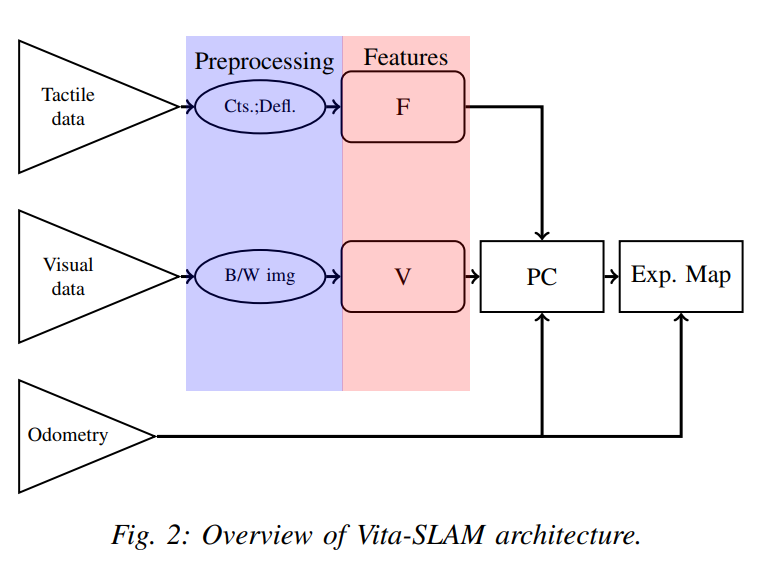
ViTa-SLAM: Biologically-Inspired Visuo-Tactile SLAM
Struckmeier, Oliver, Kshitij Tiwari, Martin J. Pearson, and Ville Kyrki. “ViTa-SLAM: Biologically-Inspired Visuo-Tactile SLAM.” arXiv preprint arXiv:1904.05667 (2019).
Abstract— In this work, Struckmeier et al. propose a novel, bio-inspired multisensory SLAM approach called ViTa-SLAM. Compared to other multi-sensory SLAM variants, this approach allows for a seamless multi-sensory information fusion whilst naturally interacting with the environment. The algorithm is empirically evaluated in a simulated setting using a biomimetic robot platform called the WhiskEye. Our results show promising performance enhancements over existing bio-inspired SLAM approaches in terms of loop-closure detection.
The following content is extracted from the paper Struckmeier et al 2019.

Fig. source: Struckmeier et al. 2019
Whilst the state-of-the-art bio-inspired SLAM model called RatSLAM was inspired by the rat hippocampal formations, it was designed purely for non-contact sensing scenarios. Similarly, WhiskerRatSLAM was designed purely for contact-sensing based SLAM. With this work, they have extended the outreach of these bio-inspired SLAM approaches to biomimetic robots bringing us one step closer to transitioning from biologically inspired to biologically plausible methodologies.
In the future works, they plan on extending our algorithm to higher dimensions to account for the full 6 DOF pose while the algorithm currently can handle upto 3 DOF pose. While this poses significant computational challenges, it is essential to generalizing the applicability of this method. Additionally, they will investigate active sensory switch mechanism to minimize rudimentary sensory data acquisition.
For further info, please read the paper Struckmeier et al. 2019.
Struckmeier, Oliver, Kshitij Tiwari, Martin J. Pearson, and Ville Kyrki. “ViTa-SLAM: Biologically-Inspired Visuo-Tactile SLAM.” arXiv preprint arXiv:1904.05667 (2019).
Salman, Mohammed, and Martin J. Pearson. “Whisker-RatSLAM Applied to 6D Object Identification and Spatial Localisation.” In Conference on Biomimetic and Biohybrid Systems, pp. 403-414. Springer, Cham, 2018.
About
CogNav Blog
New discovery worth spreading on cognitive navigation in neurorobotics and neuroscience
Recent Posts
- How to build a bio-inspired hardware implementation of an analog spike-based hippocampus memory model?
- How does the brain select what to remember during sleep?
- How hippocampal activity encodes numerous memories of specific events in life?
- How egocentric coding properties arise from its presynaptic inputs, and how egocentric cells represent items across different behavioral contexts?
- How the medial entorhinal cortex develops during learning and influences memory?
Tags
Categories
- 3D Movement
- 3D Navigation
- 3D Path Integration
- 3D Perception
- 3D SLAM
- 3D Spatial Representation
- AI Navigation
- Bio-Inspired Robotics
- Brain-Inspired Navigation
- Cognitive Map
- Cognitive Navigation
- Episodic Memory
- Excerpt Notes
- Flying Vehicle Navigation
- Goal Representation
- Insect Navigation
- Learning to Navigate
- Neural Basis of Navigation
- Path Integration
- Path Planning
- Project
- Research Tips
- Robotic Vision
- Self-Flying Vehicles
- Spatial Cognition
- Spatial Cognitive Computing
- Spatial Coordinate System
- Spatial Memory
- Time
- Unclassified
- Visual Cortex
- Visual Cue Cells
Links
- Laboratory of Nachum Ulanovsky
- Jeffery Lab
- BatLab
- The NeuroBat Lab
- Taube Lab
- Laurens Group
- Romani Lab
- Moser Group
- O’Keefe Group
- DoellerLab
- MilfordRobotics Group
- The Space and Memory group
- Angelaki Lab
- Spatial Cognition Lab
- McNaughton Lab
- Conradt Group
- The Fiete Lab
- The Cacucci Lab
- The Burak Lab
- Knierim Lab
- Clark Spatial Navigation & Memory Lab
- Computational Memory Lab
- The Dombeck Lab
- Zugaro Lab
- Insect Robotics Group
- The Nagel Lab
- Basu Lab
- Spatial Perception and Memory lab
- The Neuroecology lab
- The Nagel Lab
- Neural Modeling and Interface Lab
- Memory and Navigation Circuits Group
- Neural Circuits and Memory Lab
- The lab of Arseny Finkelstein
- The Epstein Lab
- Gu Lab (Spatial Navigation and Memory)
- Fisher Lab (Neural Circuits for Navigation)
- The Alexander Lab (Spatial Cognition and Memory)
- Harvey Lab (Neural Circuits for Navigation)
- Buzsáki Lab
- ……
